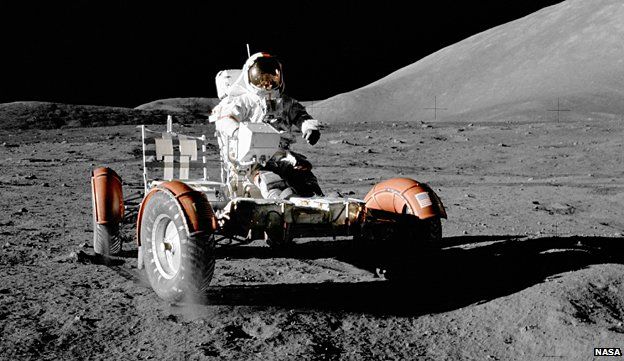Scratching the surface of the Moon
- Published
- comments

We're in the midst of Apollo nostalgia. It's now 40 years since the final mission, Apollo 17, went to the Moon.
Eugene Cernan, Ron Evans and Harrison "Jack" Schmitt were the last crew to visit Earth's satellite, with Cernan and Schmitt becoming the 11th and 12th humans to step on to its surface.
And then, as a species, we retreated.
Attending the American Geophysical Union (AGU) Fall Meeting these past few days has reminded me just how significant the Moon remains in terms of its science.
President Obama rejected it as a potential destination for future exploration ("We've been there before") in preference for asteroids.
But if you look at what we've learnt in recent years from the fleet of orbiters sent to circle the body, it just underlines that we've really only just scratched the surface.
The release of the new Grail gravity data set has probably been the stand-out moment of this AGU meeting, which brings together the world's leading Earth and planetary researchers.
It's not every day that information is placed before the scientific community that is truly transformative but the gravity maps may well fall into this class.
There's been quite a bit of talk of having to rewrite the textbooks.
The data has certainly impressed Schmitt, who continues to take a very close interest in lunar geology. Remember, he was the sole Apollo astronaut to fly as a scientist, not as a test pilot.
He's been back at AGU this week and his fascination with the Moon remains undimmed. He still thinks it's an important place for astronauts to visit.
"No question about it," he told me. "Whether you think about the science of the Moon or the resources of the Moon, or its relationship to accelerating our progress on to Mars.
Harrison Schmitt: "The science of the Moon has just been scratched"
"I'm not a big fan of asteroids [as a destination]. I think we have most of the science from meteorites, and asteroids are going to be very difficult to work around because of the very low gravity field.
"We would figure out how to do it, but I think to put together a programme to visit an asteroid when the ultimate aim is to get to Mars, and you have a satellite only three days away that has a great deal of science to offer as well as resources to offer, I think an asteroid is a diversion."
So, assuming the capability and budget existed, where on the Moon would he want to put boots?
Quick as a flash, he came back: "I'd go to South Pole Aitken Basin with significant mobility."
South Pole Aitken, or SPA, is the Moon's biggest and oldest impact feature, and is found on the far side.
It's some 2,500km across and reaches deep into the crust. SPA is suspected to have been created during a great bombardment of the inner Solar System by rocky debris that was disturbed and thrown our way when the giant planets underwent an adjustment in their orbits. That's one idea, anyway.
Scientists would dearly like to tie down the timing of this cataclysm, and getting rocks from SPA is the way to do that.
It would also probably tell us something about ourselves, says Brad Jolliff, a lunar expert from Washington University, St Louis.
"The earliest life on Earth looks to be around the time of 3.8bn years ago. That's about the time this cataclysm stopped.
Brad Jolliff: "It's like a continent on Earth - a whole separate terrain"
"The earlier period on Earth is really largely gone. This is called the Hadean Eon. From that time, the oldest materials we have are tiny crystals, bits of the mineral zircon.
"It's a resistant mineral so the rock can be melted and eroded, and all we have left are these zircons. So we can see [something of] that earlier time. But we don't really have any rocks from that time. So having the lunar samples, which nearly all come from that time period, gives us a snapshot that we can't see on Earth."
Putting astronauts down on the far side to do field work is obviously the dream. A more realistic near-term scenario is a venture that returns SPA rocks to Earth robotically, something Jolliff has long advocated.
"I would absolutely love to see astronauts there, and it will happen someday. We'll have astronauts in various places on the Moon. But in the foreseeable future it's just not in the realm of the fiscal reality that we're faced with."